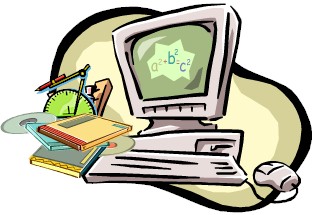Math Topics
Learning Support
Professional
![]()
[ ABC ] [ DEF ] [ GKL ] [ MNO ] [ PQR ] [ SYZ ]
![]()

Click on an alphabet range above to read the math product description and vendor contact information. Check the list below for math software titles.
Note:
Grade levels in a vendor's product description are sometimes indicated specifically with numbers (e.g., grades 1-12), or with words such as elementary, middle, high school, "and up" or "to adult". An age range might be provided instead of a grade level.
Sometimes no grade level is indicated, particularly if a product is for a specific subject (e.g., algebra, geometry, calculus, etc.).
Some products are developed only for preparation for standardized testing. Some states give grade level exams, high school exit exams, or end of course exams. There are standardized college entrance exams or the high school equivalency exam. A product might be designed to accommodate any or all of those and no grade level is promoted in the product description.
Some vendors design their products to be used in one state only or several states. What you get in terms of a grade level depends on the state you select.
Bottom line: A particular grade band or age range is only a guide; best judgment is needed when selecting products, as some might also be used for other than their intended purpose (e.g., acceleration or remediation).
|
|
Product Effectiveness Research
 Evidence for ESSA
is a free website from the Center for Research and Reform in Education at Johns
Hopkins University. Its purpose is to provide educators with the most
up-to-date and reliable information regarding K-12 programs (e.g., in math and reading)
that meet the strong, moderate, and promising evidence criteria per the ESSA.
Evidence for ESSA
is a free website from the Center for Research and Reform in Education at Johns
Hopkins University. Its purpose is to provide educators with the most
up-to-date and reliable information regarding K-12 programs (e.g., in math and reading)
that meet the strong, moderate, and promising evidence criteria per the ESSA.
What Works Clearinghouse: Easily find what works among the many topics addressed and within publications and reviews.
The Software & Information Industry Association (SIIA), the principal association representing the software and digital content industries, is conscious of contributing research on product effectiveness. The SIIA released a report on May 13, 2010, Conducting and Reporting Product Evaluation Research: Guidelines and Considerations for Educational Technology Publishers and Developers," which provides 22 standards of research best practices for publishers and developers of educational software and other instructional technologies. The guidelines do not endorse use of a particular research methodology and can also benefit school leaders who select and implement technology-based products and services, according to SIIA's media release at that time.
![]()
Click on an alphabet range to read the product description and contact information.
[ ABC ] [ DEF ] [ GKL ] [ MNO ] [ PQR ] [ SYZ ]
![]() See
Math Software (section start for more
information) | Math Software
and App Evaluation Form
See
Math Software (section start for more
information) | Math Software
and App Evaluation Form